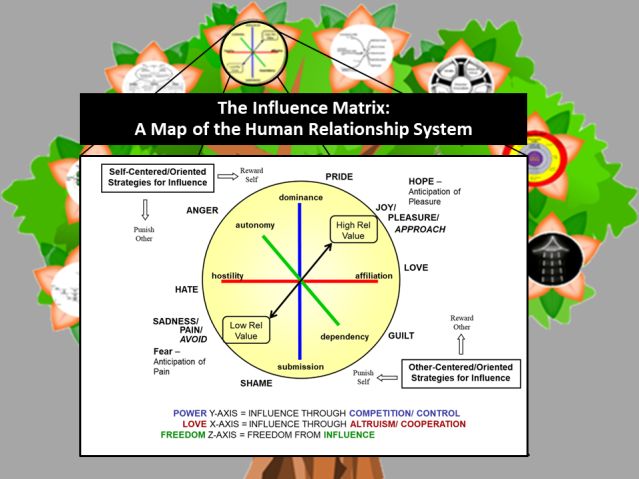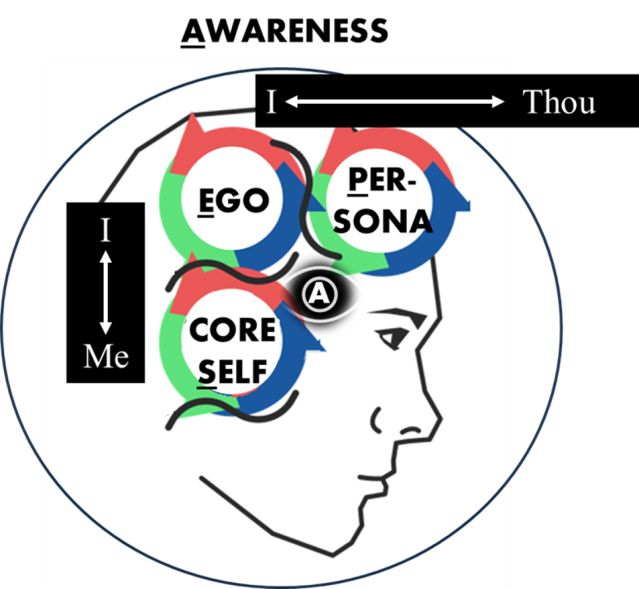Consciousness
The Four Vectors of Human Consciousness
Considering the four domains of consciousness as vectors.
Updated June 4, 2024 Reviewed by Tyler Woods
In math, a vector is a quantity that has a magnitude and direction. The word vector can also be used as a verb. To vector toward something is to guide your craft toward a particular destination.
This blog divides human consciousness into four primary vectors. In prior blogs, I have referred to them as domains and attractor states (e.g., here or here). Framing them as vectors is useful because it can be helpful to analyze them in terms of magnitude and direction of focus.
The first vector is the “I”. This is the Ego, and it is the domain of self-conscious reflection and narration. In adults, it is the domain that holds dominion and a sense of personal ownership and responsibility for what one does. In UTOK, the Unified Theory of Knowledge, the Ego is framed as the mental organ of justification1. Its attractor state is to find a justified state of being. This means it tries to develop a coherent story that feels familiar and that cognitive dissonance is reduced. It can also be considered “the interpreter” of our minds. Developmentally, it starts to come online via language and socialization around the age of two; however, it only becomes a central organizing vector around the age of six. From there, the Ego grows in magnitude. By adolescence, it has transformed to become the primary seat of the person’s identity.
The second vector is the core, primate Self. Although many systems equate the Ego with the Self, in UTOK, these are recognized to be very different aspects of our structure. The relationship between the two can be helpfully framed via what William James called the “I-Me” relation. Consider when a therapist asks: “How do you feel?” and the client says, “I think I feel a bit angry about all this.” This is an example of their Ego introspecting on their core Self.
The core Self is a perceiving, motivated, emotional system that tracks what is relevant for the self over time and from a point of view. It can be framed as having “vertical layers” that follow our evolutionary history. There is a basic animal layer, which is the seat of feelings like pleasure, pain, hunger, and fear. Then, there is a mammallian layer, which includes an implicit model of the self over time. This model allows mammals to mentally project themselves into different possible environments and simulate possible outcomes (e.g., when a rat gets to a choice point in a maze, it will simulate various paths and choose the one it expects to be most rewarding/least punishing).
The third evolutionary layer is the primate layer, which, in humans, is a highly relational structure. UTOK maps the relational aspects of our primate selves via the Influence Matrix. The matrix posits that the human heart (i.e., the primate core Self) is structured via self-in-relation-to-other processes, which can, coincidentally, also be mapped on four vectors.

The central dimension is the relational value-social influence vector, and it tracks the degree of social influence one has, as well as the extent to which one feels seen, known, and valued by important others. The matrix also maps three “process” vectors, called power, love, and freedom. The power vector relates to rank, control, and status, and it is marked by the blue line and dominance and submission poles. The love vector is in red, and it relates to the degree and kind of affiliation one has with others (e.g., kinship, friendship, romantic, group), and its opposite: hostile reactivity and distancing. The freedom vector is in green, and it tracks the level of involvement, engagement, and dependency, and is marked by the poles of autonomy and dependency. The primate self is operative at birth and the first major attractor is to orient the infant to connect with and be held securely by their primary caretaker.
Many folks, perhaps especially men, are quite alienated from their core Self, and do not have much practice attending to this vector with attunement and care. In common language, their head is not well-aligned with their heart. That said, the core Self is incredibly powerful in shaping how humans are situated in and operate in the world. The relationship between these two vectors of human consciousness was well-framed by Freud as that of a rider (Ego) and horse (Self). It was usefully updated by the social psychologist Jonathan Haidt as that of a rider and an elephant, to emphasize the magnitude of its influence on the human psyche.
The third vector is the Persona. This can be thought of as the social self or public-facing self. The Persona represents a real or imagined audience and how it can impact our conscious experience. The primary attractor is the image one tries to convey and regulate in the relational context. To use a frame from Martin Buber, we can think of the Ego-Persona relation as being the basic frame we use to embody I-Thou relations.
Individuals who experience high levels of public self-consciousness are folks who have a strong but insecure Persona vector. Because it represents the information and image one is conveying to the relational field and how that is received, it is guided by both the primate Self and the Ego. However, as the Ego develops, the Persona becomes more explicitly linked to the Ego. The reason has to do with the nature of and dynamics surrounding justification1. Unlike subjective feelings and experiences, justifications flow freely through the skin. In humans, the Ego can be directly contacted by others with questions like, “Why did you do that?” Because of this, regulating what others might come to know about us is a major task, and so the Persona becomes a central attractor that we need to navigate. (See here for a recent blog on the filter dynamics between the Ego and the Persona).

To see the last vector, close your eyes and then open them. What happens? You are simply presented with a flash of pure Awareness. In an instant, you experience what “is” in the “now.” Each frame of experience can be thought of as a moment of epistemic awareness.
We can call this vector pure Awareness accessed via witness consciousness. You can play with the pure awareness vector by where you direct your attention. You can think of your grandmother, shift to your big toe, and come back to the point of this blog. Many meditation traditions and practices are structured to help folks get in contact with witness consciousness. Some do this by emphasizing attention and concentration. Others do it by emphasizing the pure awareness aspect of the witness function. Indeed, in advanced forms of mediation and practice, the witnesser can feel like they disappear, resulting in a profound sense of non-dual awareness.
I encourage you to think about your consciousness as being made up or shaped by these vectors. When they are framed as vectors, we can reflect on the magnitude and direction, and wonder if they are in healthy alignment. Is one vector dominant over the others? Are you constantly thinking about what others think of you and trying to mold yourself to that? Then perhaps your Persona vector is a bit strong. Do you frequently justify yourself by trying to explain why you are right, smart, and good? Then your Ego vector might be excessive. Do you feel things very strongly, react emotionally, and experience your feelings as “the truth”? Then your core Self might be powering you in a maladaptive way.
In terms of the witness vector of pure Awareness, in modern society, where we are obsessed with the self, the most likely problem is that it is underdeveloped relative to the other three vectors. So, the question is: Can you see this aspect of your consciousness, and do you truly know how to identify with it and connect to the here, now?
References
1. Henriques, G. R. (2003). The tree of knowledge system and the theoretical unification of psychology. Review of General Psychology, 7, 150-182.




